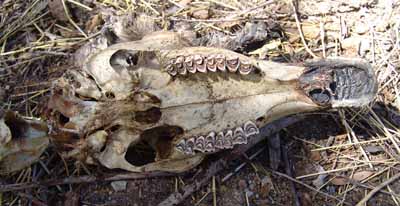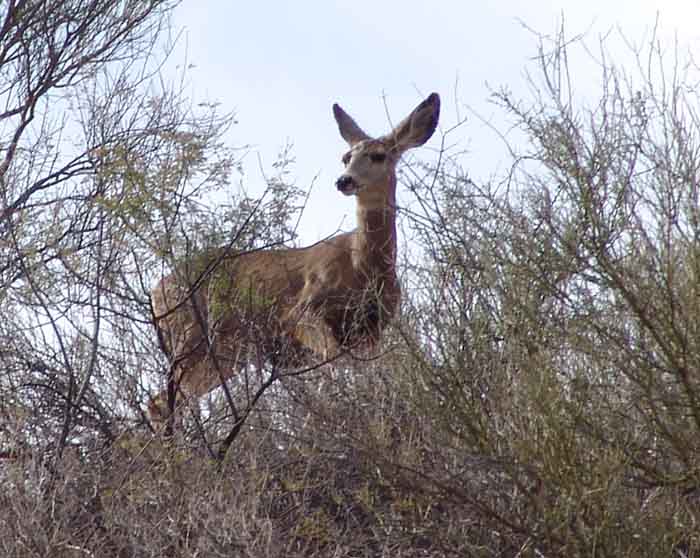
Deer (Family Cervidae)
These slim, long-legged Artiodactyls are best characterized by the presence of antlers, borne only by the males. Antlers are appendages of the skull with a solid bony core and supported on permanent skin-covered pedicels. In the temperate zone they begin to grow in summer, covered by thin hairy skin ("velvet"), attaining full size by late summer when the blood supply cuts off, the velvet falls, and the antlers serve as sexual ornaments and weapons. In the northern hemisphere the antlers are shed each year from January to April, following the mating season. Deer are ruminants, with four-chambered stomachs, their diets herbivorous. Their fossils date from the early Miocene in North America.
At left, a deer skull encountered in Sierra Blanca Canyon near Hackberry Spring in July 2004. Viewed from below, the image shows the elaboration of the grinding teeth in the middle of the photo, with a gap between those and the incisors to the right, which are missing. The top part of this deer's fleshy snout remains attached to the skull.
Click on the image to enlarge it.
So far in our Saguaro Juniper experience we have not done very well in photographing living deer, except for the banner image at the top above, photographed in January 2005 in lower Hot Springs Canyon. Our photos of live animals are mainly drawn from a video camera, so when we do begin putting video clips instead of these mainly stop-action clips into the website, visual imagery will improve somewhat. For the time being, we show a few mediocre images, plus some better ones taken of the dead.
Our deer are regularly preyed upon by our Mountain Lions -- who leave much-chewed and disarticulated skeletons scattered about in various locations, for example this much-worried array of skin and bones below, found as remarked above in July 2004. Click on images below to enlarge.
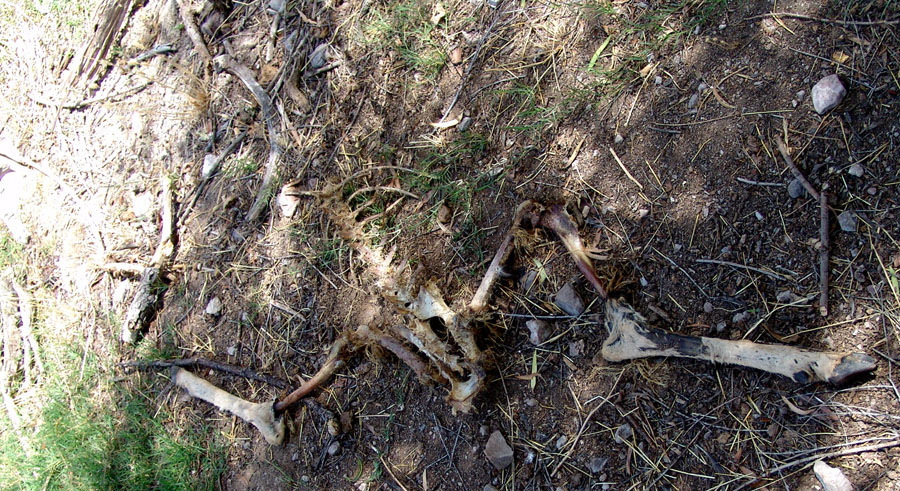
Below, this separated set of leg bones nicely illustrates the cursorial grace of the deer skeleton. Note the position of the dew claws above the hoof.
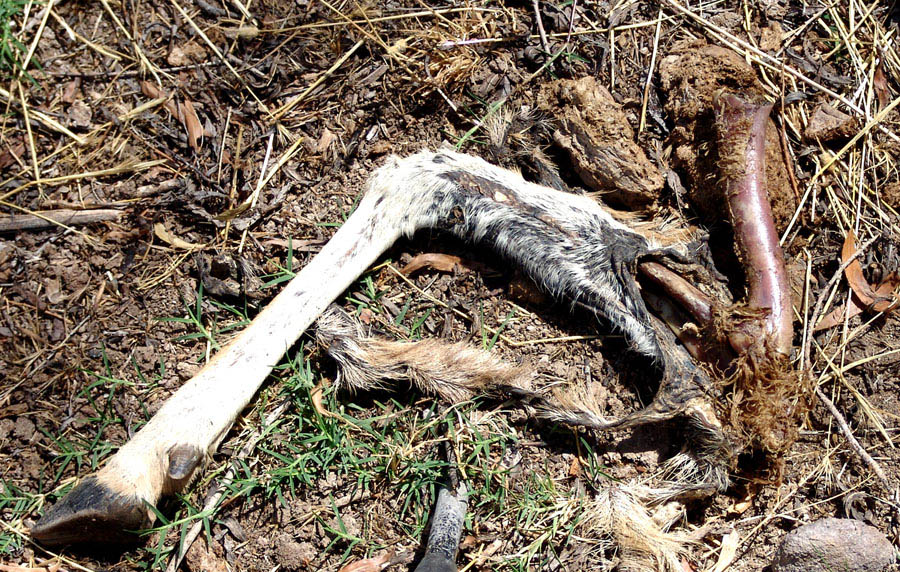
Below is a good image of the remnant flexible muzzle, and also of a long browser's neck still partly connected to its ribcage:
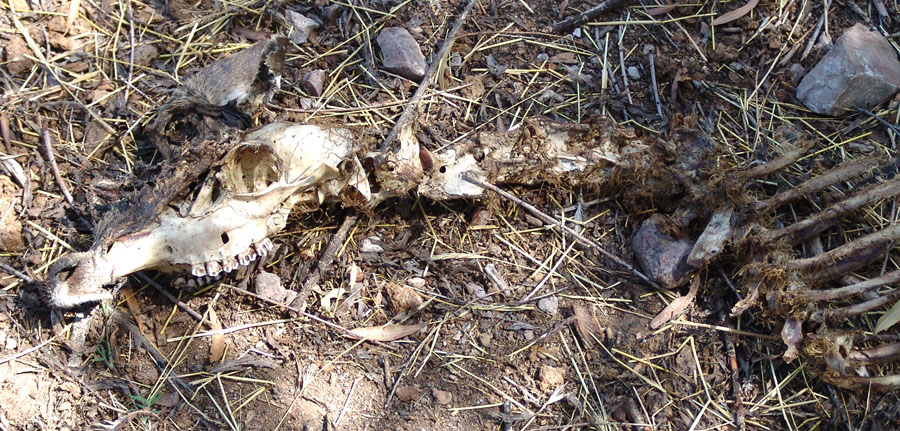
From the size of this animal we suspect it was a Mule Deer. Two species are found in our area: The Mule Deer (Odocoileus hemmionus) and the Whitetail Deer (Odocoileus virginianus). The contrasts have been nicely drawn in part of a hunting season brochure produced by the Arizona State Department of Game and Fish:
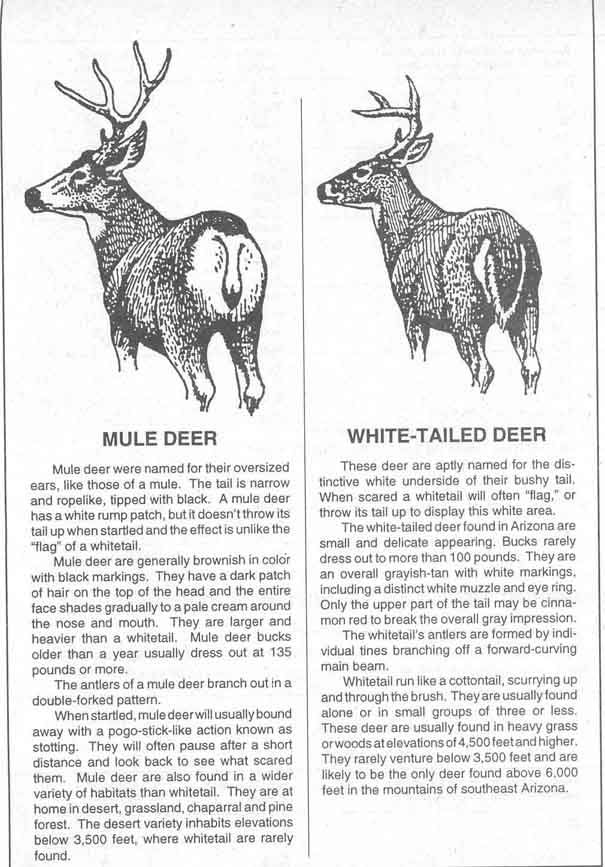
Below, part of a herd of Mule Deer we encountered near the Big Tank off lower Pool Wash in May 1996. While these deer are running at a considerable distance, you can be sure they are Mules because of their ropelike floppy tails with black tips.

No informed person would mistake these Mule Deer, encountered below on the flanks of Sierra Blanca in May 1997, for Whitetails. First, the ears are remarkably large (a Mule characteristic), and second, one deer stands watching while others ignore the cameraman (four are visible, several more are grazing nearby). Whitetail Deer don't do this.

Below, in both images the fact that we are being silently observed by stationary animals indicates that we are dealing with Mule Deer. At left, in January 2005 along terraces above lower Hot Springs Canyon, only by chance did the photographer look back while walking downhill to see the deer on the ridge overlooking him. At right, in the twilight of June 2002 at the Windmill in lower Hot Springs Canyon, a pair look quietly down at the temporary intruders. Click on each image to enlarge.
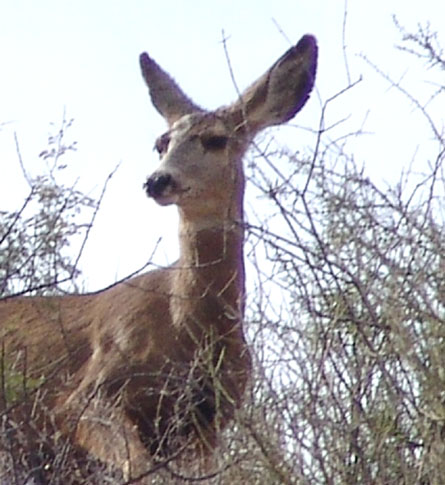 ..
..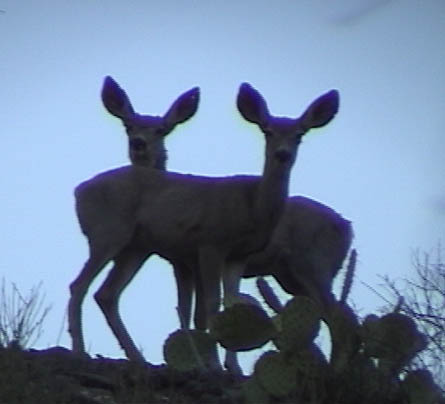
As the comparison made by our State Department of Game and Fish suggests, Mule Deer are more numerous in our area (though nowhere do we encounter them with great regularity), sometimes appearing in herds of a dozen or more, while our White-tailed Deer seldom number more than four, usually fewer. Our Whitetail Deer appear to be of the variety called "Coues Deer" (Odocoelius virginianus couesi) , which are very small. One of them, spooked one day from beneath a shrub on the Pool Wash Ridge Road, looked like an overgrown jackrabbit (though perhaps we exaggerate). This Coues variety appears to be adapted to lower elevations and drier conditions than the main branch of White-tailed Deer, and according to Hoffmeister (p. 545) it is "allied to the small sub-species of Mexico and Central America." Hoffmeister also suggests that it appears to be spreading into higher elevations of the Mogollon Plateau, where previously the Main Branch White-tails were more common. (p. 548) Main Branch White-tails appear to be in decline over much of Arizona (p. 545).
In contrast, in many parts of the Eastern United States, where natural predators have been eliminated and the vegetation preferred by White-tailed Deer is much more densely distributed, the White-Tailed species has exploded in recent years, from a low of a few hundred thousand in 1900 to many million today, reaching densities of hundreds per square mile in some places. From Wisconsin to Connecticut to Virginia, the White-tails have invaded suburban landscapes where artificially fertilized and regularly-watered lush gardens offer a wealth of flowers and shrubs on which to feed (and where local residents may "put out 50-pound sacks of corn to attract the graceful creatures.". In turn, Mountain Lions, extirpated from most locations east of the Mississippi River a hundred years ago, are returning in considerable numbers to these places which are now being over-run by their favorite food: deer. In Northern Michigan, where Mountain Lions have been absent since the end of the nineteenth century, seven were confirmed in residence by 2001, and a juvenile male killed near Kansas City in 2002 was the first free-ranging mountain lion seen in that region in more than 100 years. [See The Science Times, in The New York Times November 12, 2002.]
When they encounter humans, White-tail Deer run from the viewer until they are completely out of sight (with their sharply upright, flame-shaped tails showing a bright flash of white). Our sole photographic image of our Coues White-tailed so far is the following, below, scampering away from the Notch Basin in October of 1998, a blurry picture which at least has the virtue of providing an impression of that spectacular departing tail:
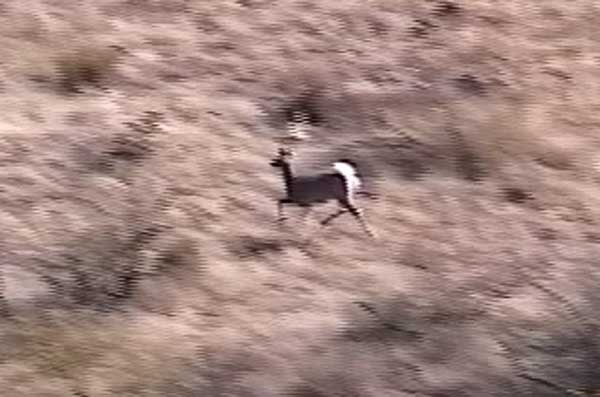
More typically, while we may surprise both ourselves and the deer in question at close range, typically White-tails dart away so fast that by the time our cameras are ready they are either mere dots in the distance or entirely gone.
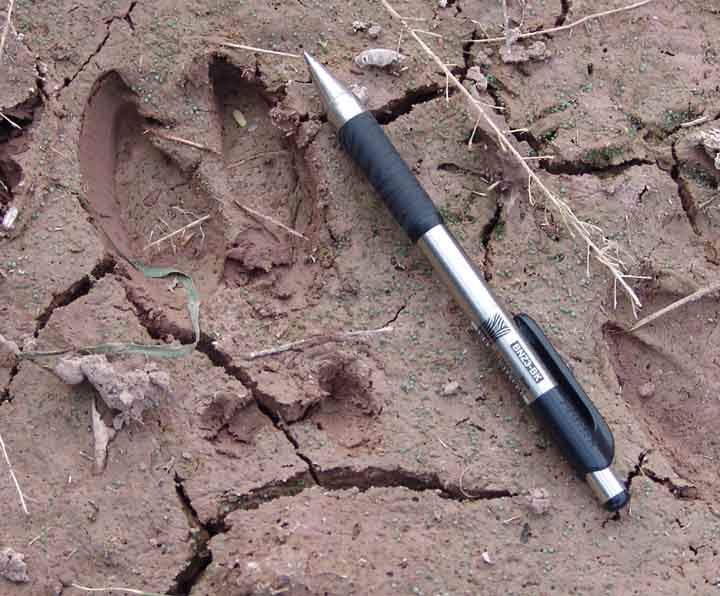 At left, a deer track in mud shows the characteristic "dew claws" behind the main hoofs, which are only visible in mud. The length of the track is close to 4", suggesting a Mule Deer.
At left, a deer track in mud shows the characteristic "dew claws" behind the main hoofs, which are only visible in mud. The length of the track is close to 4", suggesting a Mule Deer.

Above, a fine image of a mule deer taken with automatic infra-red camera in lower Hot Spring Canyon on December 12, 2008.
Back to Mammals
